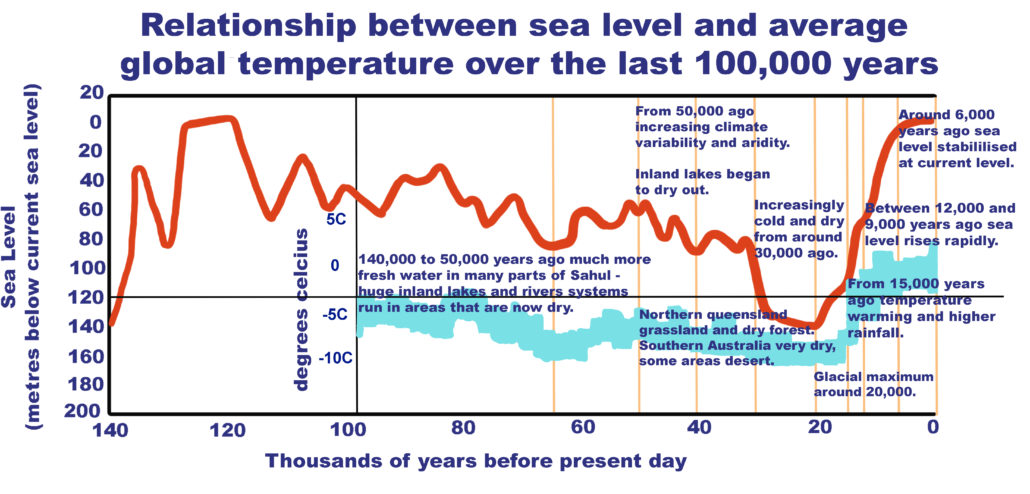Climate, People and Country

Language Points
Guugu Yimithirr
65,000 years ago the world was going through an Ice Age. The climate in Sahul was different to what we know today. The weather was colder and until about 40,000 years ago rainfall was more abundant. This means there was more freshwater around compared to today. For example, until about 40,000 years ago there were rivers in the Channel County, which has since become a very dry area. Also, there was a great freshwater lake where the Gulf of Carpentaria is today. It is this abundance of freshwater that made it possible for people to reach every part of the country.
It is difficult to know for sure how things were back then, but scientists think the climate was a lot more variable than it is today: there were periods of warmer temperatures when there was high rainfall followed by periods of colder weather when there was low rainfall. These two weather systems would switch back and forth in an unpredictable way.
Some scientists think that due to these unpredictable conditions the number of people back then could not grow very large and that our ancestors lived in small groups scattered across the country. Other scientists disagree with this and think that there were regions where water was always abundant and that allowed a great number of people to thrive.
The vegetation was of course also affected by temperature and rainfall changes. Scientists think that by around 30,000 years ago, when the earth was getting much colder, the land that is now Queensland was partly covered in grasslands and partly in dry forest. They think that much of the south of the country was desert by that time.
English
65,000 years ago the world was going through an Ice Age. The climate in Sahul was different to what we know today. The weather was colder and until about 40,000 years ago rainfall was more abundant. This means there was more freshwater around compared to today. For example, until about 40,000 years ago there were rivers in the Channel County, which has since become a very dry area. Also, there was a great freshwater lake where the Gulf of Carpentaria is today. It is this abundance of freshwater that made it possible for people to reach every part of the country.
It is difficult to know for sure how things were back then, but scientists think the climate was a lot more variable than it is today: there were periods of warmer temperatures when there was high rainfall followed by periods of colder weather when there was low rainfall. These two weather systems would switch back and forth in an unpredictable way.
Some scientists think that due to these unpredictable conditions the number of people back then could not grow very large and that our ancestors lived in small groups scattered across the country. Other scientists disagree with this and think that there were regions where water was always abundant and that allowed a great number of people to thrive.
The vegetation was of course also affected by temperature and rainfall changes. Scientists think that by around 30,000 years ago, when the earth was getting much colder, the land that is now Queensland was partly covered in grasslands and partly in dry forest. They think that much of the south of the country was desert by that time.

Map of vegetation zones glacial maximum
30,000 – 15,000 years ago
Starting from around 30,000 years ago the climate gradually became colder and colder, windier and drier. Between 24,000 and 18,000 years ago it became the coldest and driest it had ever been since people arrived in Sahul. Scientists call this period the ‘Last Glacial Maximum’. Back then temperatures would have been between 9 and 6 degrees Celsius lower than today.
Glaciers developed in the Snowy Mountains (NSW) and in the Tasmanian Highlands.
Dry forests and wood-shrublands survived through this period but many areas of southern Australia became barren.
Dry conditions lasted longer in some areas. Northern Cape York stayed rather dry until 10,500 years ago and the rainforest probably shrank to small patches during this time. The dominant vegetation for much of this area was sclerophyll woodland. Lake Carpentaria and the Atherton Tablelands were covered in open eucalypt woodland.
During this time there was a stark decrease in available freshwater and in plant and animal foods that people could rely on and so, many areas were abandoned, as they became uninhabitable. People gathered around a few ‘refuge’ areas where permanent freshwater sources were available and where it was still possible to find plant and animal foods. People would have been less mobile during this time.
Some scientists think that in these very difficult conditions the number of people living in the country diminished by more than half (population fell by an estimated 60%).

Map of refuge areas glacial maximum
15,000 – 6,000 years ago
From around 15,000 years ago the temperatures became warmer and rainfall gradually increased. As the climate changed, the vegetation also changed, and as plant and animal foods became more abundant the number of people living in the county increased. Now that more freshwater was available once again, people returned to live in the areas that had been abandoned. Forests and woodland expanded again in the areas that had been barren in the south of the country.

Map or image
12,000 to 9,000 years ago.
As the temperatures warmed, the glaciers and ice caps melted. This resulted in the sea levels rising. Between 12,000 and 9,000 years ago the sea rose very rapidly, changing Country dramatically.
During this time Tasmania became cut off from the mainland.
Salt water also made its way into Lake Carpentaria, making it brackish at first, until the whole area was completely flooded and became the Gulf we know today.
It is also during this time that the coast in Cape York slowly receded and the land bridge that connected us to Papua New Guinea disappeared under the water. The only land that remained above sea level are the islands off the coast and in the Torres Strait that we know today. It is during this time that underwater the Great Barrier Reef started growing and that people started telling the stories about Sea Country that we still know today (for more on this read section: The oldest stories in the world).

Map or image
9,000 and 5,000 years ago
Between 9,000 and 5,000 years ago the climate became very warm and there was lots of rain, more than there is today. From about 8,000 years ago, because there was more rain, the rainforest, wet sclerophyll forests and open forests expanded rapidly in Cape York.
The sea levels stabilised to what we know today about 6,000 years ago.
The number of people continued increasing during this favourable time.

Map or image
5,000 years ago to today
Once the sea stopped rising, the coastal environments stabilised and developed, including mangroves and inland freshwater swamps. The Great Barrier Reef grew so much that it is now visible from space. Most features of the present-day landscape were established around then.
During this time the number of people increased quickly, especially between 1,600 and 400 years ago. We don’t know how many people lived in Australia at the time when Europeans first arrived (1788). Some scientists think there would have been around 250,000/300,000 people while others think there would have been around 1,200,000 people or even more.
From about 5,000 years ago the weather started becoming more variable once again. This weather variability has been named by scientists ‘El Niño Southern Oscillation’. It became most intense between 2,500-1,700 years ago with rain becoming highly seasonal (monsoons) and leading to periods of drought. This weather pattern is the one we are used to today, where we have an El Niño phase with less rain and cooler temperatures alternating with a La Niña phase with more abundant rain and warmer temperatures (?).
During this time people started permanently living in the rainforest of Cape York and learned how to process toxic nut varieties for food. Schelrophyll woodlands came to cover a good part of Queensland, together with shrubland. Grasslands are still present but receded further south.
BIBLIOGRAPHY
- Moss, P.T., Cosgrove R.,Asa F., Haberle S.G. 2012. Holocene environments of the sclerophyll woodlands of the Wet Tropics of northeastern Australia. In Peopled Landscapes: Archaeological and Biogeographic Approaches to Landscapes, Simon G. Haberle and Bruno David (eds.). Canberra : ANU Press.
- Bird R.B. et al. 2008. The ‘fire stick farming’ hypothesis: Australian Aboriginal foraging strategies, biodiversity, and anthropogenic fire mosaics. In PNAS, vol.105, n.39, 14796-14801
- Haberle, S. et al. 2010. Paleofire in the wet tropics of northeast Queensland, In PAGES news, vol. 18(2), 78-80
- Cosgrove, R., Judith Field and Asa Ferrier. 2007. The archeology of Australia’s tropical rainforests. In Palaeogeography, Palaeoclimatology and Palaeoecology 251, 150-173.
- Vaesen K., Collard M., Cosgrove R., Roebroeks. 2016. Population size does not explain past changes in cultural complexity. In ‘Proceedings of the National Academy of Science of the United States of America’, Vol. 113, n.16 (April 19, 2016), pp.E2241-E2247
- Climate in Australia through the last 72,000 years https://theconversation.com/burnt-ancient-nutshells-reveal-the-story-of-climate-change-at-kakadu-now-drier-than-ever-before-152760
- Williams, Alan N. 2013. A new population curve for prehistoric Australia. In ‘Proceedings of the Royal Society B’. 280: 20130486
- Bradshaw et al. 2021. Stochastic models support rapid peopling of Late Peistocene Sahul. In Nature Communications: https://www.nature.com/articles/s41467-021-21551-3.pdf
- De Dekker et al 2020. Climatic evolution in the Australian region over the last 94 ka – spanning human occupancy -, and unveiling the Last Glacial Maximum. Quaternary Science Reviews Volume 249, 1 December 2020, 106593
https://www.sciencedirect.com/science/article/abs/pii/S0277379120305552
- Gilbert J. Price Quaternary. In Jell, P. (ed.) Geology of Queensland. Geological Survey of Queensland, Brisbane. 653-686.
Tobler et all. March 2017, pp.180-184. Aboriginal mitogenomes reveal 50,000 years of regionalism in Australia. In Nature 54
